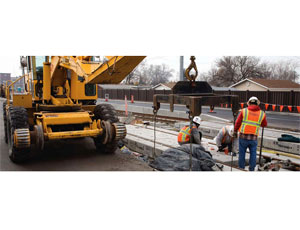The Utah Transit Authority in Salt Lake City is currently in the midst of more than $1.15-billion worth of construction on five major projects along the Wasatch Front.

The UTA projects include the $485-million FrontRunner South from Salt Lake City to Provo, the $186-million Salt Lake International Airport TRAX line, the $205-million Mid-Jordan TRAX line, the $189-million West Valley City TRAX line and the $87-million Draper TRAX line.
These ambitious, multifaceted projects will greatly expand mass transit service for the more than 1.5 million residents along the approximately 100-mile-long Wasatch Front corridor from Ogden to Provo.
“We have undertaken several significant projects at the same time with a goal of having everything completed before the end of 2012,” says UTA spokesperson Gerry Carpenter. “We have assembled some great construction teams, and right now every one of the projects is progressing well.”
Ambitious Program
Carpenter says UTA’s FrontLines 2015 program will include more than 70 total miles of new rail, including 926,000 lin ft of rail, 184,000 concrete ties and 25 new traction power substations. UTA plans to utilize 77 new light-rail vehicles on its TRAX lines. Additionally, FrontRunner South will incorporate 10 new locomotives, eight bilevel coaches, 10 refurbished bilevel cabs and 25 single-level coaches.
Each project has required intense coordination among UTA officials, designers, contractors and the public entities impacted by the various projects.
“It’s good for the local economy from a job standpoint,” says Jim Webb, UTA senior project manager for more than seven years. “Keeping these projects moving has been challenging on so many levels, but it’s important for us to look at the big picture, which is offering mass transit to all residents along the Wasatch Front.”
Webb says sales tax is the biggest single contributor to UTA projects, and that has been hampered by the recession.
“We’re starting to gain (tax revenue) back, but we’re not even at the baseline yet,” he adds. “Our baseline cost per mile is near the lowest in the nation, which is helping us build these significant projects and double our mileage of existing rail lines.”
South Side Rail
At $485 million, FrontRunner South costs considerably less than the $612-million FrontRunner North, which...

Post a comment to this article
Report Abusive Comment